Refuge Lake Reclassification in 620 Minnesota Cisco Lakes under Future Climate Scenarios
Abstract
:1. Introduction
2. Methodology
2.1. Methodology Overview
2.2. Four Types of Virtual Lakes Representing 620 Cisco Lakes in Minnesota
3. Results and Discussion
3.1. Variable Benchmark Periods
3.2. AvgATDO3VB of Four Types Virtual Lakes
3.3. Validation of Refuge Lake Reclassification
3.4. Cisco Lakes Reclassification in Minnesota
3.5. Comparison and Discussion of Reclassification with Results in the Previous Study
4. Summary and Conclusions
Acknowledgments
Author Contributions
Conflicts of Interest
Appendix A
| Lake Type (Region) 1 | Lake ID 2 | Name | As (ha) | Hmax (m) | GR (m−0.5) | SD (m) |
|---|---|---|---|---|---|---|
| M (Nor) | 38071500 | Triangle | 125.10 | 13.11 | 2.55 | 5.42 |
| M (Mid) | 11086600 | Tamarack | 4.33 | 13.11 | 1.10 | 3.81 |
| M (Nor) | 16058000 | Granite | 8.10 | 13.72 | 1.23 | 4.25 |
| M (Nor) | 38052400 | Portage | 27.94 | 13.72 | 1.68 | 4.27 |
| M (Nor) | 69006600 | Little Long | 118.62 | 13.72 | 2.41 | 5.56 |
| M (Mid) | 11046900 | Anway | 8.91 | 13.72 | 1.26 | 3.96 |
| M (Mid) | 11004700 | Mule | 25.10 | 13.72 | 1.63 | 4.57 |
| M (Mid) | 18021100 | Blue | 39.27 | 13.72 | 1.83 | 7.74 |
| M (Mid) | 31077500 | No-ta-she-bun | 96.36 | 13.72 | 2.28 | 6.65 |
| M (Mid) | 18020800 | Allen | 20.24 | 14.02 | 1.51 | 4.11 |
| M (Mid) | 18035800 | Bass | 46.96 | 14.32 | 1.83 | 5.06 |
| M (Mid) | 16002700 | McFarland | 155.47 | 14.93 | 2.36 | 5.26 |
| M (Mid) | 1005700 | Little Ball Bluff | 13.77 | 14.93 | 1.29 | 3.66 |
| MD (Nor) | 16061600 | Devils Elbow | 35.99 | 15.24 | 1.61 | 3.96 |
| MD (Nor) | 31019600 | Poplar | 39.27 | 15.24 | 1.64 | 3.96 |
| MD (Mid) | 31027800 | Barwise | 37.25 | 15.24 | 1.62 | 5.79 |
| MD (Nor) | 38071400 | Section Twelve | 17.41 | 15.85 | 1.29 | 5.49 |
| MD (Mid) | 18003000 | Barbour | 20.65 | 16.46 | 1.30 | 4.72 |
| MD (Nor) | 69033700 | Thumb | 21.05 | 16.76 | 1.28 | 3.35 |
| MD (Nor) | 69048000 | Beartrack | 68.26 | 16.76 | 1.71 | 4.02 |
| MD (Nor) | 38049100 | Vera | 99.19 | 16.76 | 1.88 | 5.26 |
| MD (Mid) | 31021800 | Shamrock | 23.89 | 16.76 | 1.32 | 4.57 |
| MD (Mid) | 11006900 | Bass | 86.23 | 16.76 | 1.82 | 5.33 |
| MD (Nor) | 69021300 | Toe | 67.21 | 17.37 | 1.65 | 4.57 |
| MD (Mid) | 31039900 | Little Wabana | 42.11 | 17.37 | 1.47 | 4.71 |
| MD (Nor) | 38050200 | Ashigan | 76.52 | 17.98 | 1.64 | 7.62 |
| MD (Mid) | 11048200 | May | 49.80 | 17.98 | 1.48 | 3.96 |
| MD (Nor) | 31091100 | Hamrey | 17.81 | 18.29 | 1.12 | 4.27 |
| MD (Nor) | 69076100 | Spring | 78.54 | 18.29 | 1.63 | 4.57 |
| MD (Nor) | 69034800 | Finger | 116.19 | 18.29 | 1.80 | 3.96 |
| MD (Mid) | 11046600 | Fifth | 18.46 | 18.29 | 1.13 | 4.95 |
| MD (Mid) | 31077800 | Little Too Much | 27.13 | 18.29 | 1.25 | 4.27 |
| MD (Mid) | 31046600 | Horseshoe | 51.42 | 18.29 | 1.46 | 4.27 |
| MD (Mid) | 31037300 | Hale | 57.49 | 18.29 | 1.51 | 4.77 |
| MD (Mid) | 31057500 | Little Bass | 62.75 | 18.90 | 1.49 | 4.77 |
| MD (Mid) | 56082900 | Pebble | 68.42 | 18.90 | 1.52 | 4.31 |
| MD (Mid) | 29023700 | Newman | 15.79 | 19.20 | 1.04 | 4.88 |
| MD (Mid) | 18039600 | Edna | 61.94 | 19.20 | 1.46 | 4.75 |
| MD (Mid) | 18036400 | Clear | 89.07 | 19.20 | 1.60 | 4.65 |
| MD (Nor) | 69047300 | Eugene | 67.21 | 19.51 | 1.47 | 3.35 |
| MD (Mid) | 18029800 | East Fox | 96.76 | 19.81 | 1.58 | 5.08 |
References
- Frey, D.G. Distributional ecology of the cisco, Coregonus artedi, in Indiana. Investig. Indiana Lakes Streams 1955, 4, 177–228. [Google Scholar]
- Fry, E.F.J. The Effect of Environmental Factors on the Physiology of Fish; Academic Press: New York, NY, USA, 1971; Volume 6. [Google Scholar]
- Blumberg, A.F.; Di Toro, D.M. Effects of climate warming on dissolved oxygen concentrations in Lake Erie. Trans. Am. Fish. Soc. 1990, 119, 210–223. [Google Scholar] [CrossRef]
- Stefan, H.G.; Hondzo, M.; Fang, X.; Eaton, J.G.; McCormick, J.H. Simulated long-term temperature and dissolved oxygen characteristics of lakes in the north-central United States and associated fish habitat limits. Limnol. Oceanogr. 1996, 41, 1124–1135. [Google Scholar] [CrossRef]
- Fang, X.; Stefan, H.G. Projection of climate change effects on water temperature characteristics of small lakes in the contiguous U.S. Clim. Chang. 1999, 42, 377–412. [Google Scholar] [CrossRef]
- Fang, X.; Stefan, H.G. Projected climate change effects on winterkill in shallow lakes in the northern U.S. Environ. Manag. 2000, 25, 291–304. [Google Scholar] [CrossRef]
- Livingstone, D.M. Impact of secular climate change on the thermal structure of a large temperate central European lake. Clim. Chang. 2003, 57, 205–225. [Google Scholar] [CrossRef]
- Hamilton, D.P.; Schladow, S.G. Prediction of water quality in lakes and reservoirs. Part I—Model description. Ecol. Model. 1997, 96, 91–110. [Google Scholar] [CrossRef]
- Cole, T.M.; Wells, S.A. CE-QUAL-W2: A Two-Dimensional, Laterally Averaged, Hydrodynamic and Water Quality Model, Version 3.6 User Manual; Department of Civil and Environmental Engineering, Portland State University: Portland, OR, USA, 2010. [Google Scholar]
- Jiang, L.; Fang, X.; Stefan, H.G.; Jacobson, P.C.; Pereira, D.L. Identifying cisco refuge lakes in Minnesota under future climate scenarios using variable benchmark periods. Ecol. Model. 2012, 232, 14–27. [Google Scholar] [CrossRef]
- Jiang, L.; Fang, X. Simulations and validation of cisco lethal conditions in Minnesota lakes under past and future climate scenarios using constant survival limits. Water 2016, 8, 279. [Google Scholar] [CrossRef]
- Fang, X.; Jiang, L.; Jacobson, P.C.; Stefan, H.G.; Alam, S.R.; Pereira, D.L. Identifying cisco refuge lakes in Minnesota under future climate scenarios. Trans. Am. Fish. Soc. 2012, 141, 1608–1621. [Google Scholar] [CrossRef]
- Fang, X.; Jiang, L.; Jacobson, P.C.; Fang, N.Z. Simulation and validation of cisco habitat in Minnesota lakes using the lethal-niche-boundary curve. Br. J. Environ. Clim. Chang. 2014, 4, 444–470. [Google Scholar] [CrossRef] [PubMed]
- Benyahya, L.; Caissie, D.; St-Hilaire, A.; Ouarda, T.B.; Bobée, B. A review of statistical water temperature models. Can. Water Resour. J. 2007, 32, 179–192. [Google Scholar] [CrossRef]
- Imberger, J.; Patterson, J.C. A dynamic reservoir simulation model—DYRESM. In Transport Models for Inland and Coastal Waters; Fischer, H.B., Ed.; Academic Press: New York, NY, USA, 1981; Chapter 9; p. 483. [Google Scholar]
- Ambrose, R.; Wool, T.; Martin, J. WASP 5, The Water Quality Analysis Simulation Program Version 5.00; AscI Corporation: Athens, GA, USA, 1993. [Google Scholar]
- Craig, P.M. User's Manual for EFDC_Explorer 7: A Pre/Post Processor for the Environmental Fluid Dynamics Code; Dynamic Solutions-International, LLC: Edmonds, WA, USA, 2012. [Google Scholar]
- Fang, X.; Stefan, H.G. Development and Validation of the Water Quality Model MINLAKE96 with Winter Data; St. Anthony Falls Laboratory, University of Minnesota: Minneapolis, MN, USA, 1996. [Google Scholar]
- Fang, X.; Alam, S.R.; Jacobson, P.; Pereira, D.; Stefan, H.G. Simulations of Water Quality in Cisco Lakes in Minnesota; St. Anthony Falls Laboratory, University of Minnesota: Minneapolis, MN, USA, 2010. [Google Scholar]
- Thiery, W.; Stepanenko, V.M.; Fang, X.; Jöhnk, K.D.; Li, Z.; Martynov, A.; Perroud, M.; Subin, Z.M.; Darchambeau, F.; Mironov, D.; et al. LakeMIP Kivu: Evaluating the representation of a large, deep tropical lake by a set of one-dimensional lake models. Tellus A 2014, 2014, 21390. [Google Scholar] [CrossRef] [Green Version]
- Cahn, A.R. An ecological study of southern Wisconsin fishes, the brook silverside and the cisco, in their relation to the region. Ill. Biol. Monogr. 1927, 11, 1–151. [Google Scholar]
- Jacobson, P.C.; Jones, T.S.; Rivers, P.; Pereira, D.L. Field estimation of a lethal oxythermal niche boundary for adult ciscoes in Minnesota lakes. Trans. Am. Fish. Soc. 2008, 137, 1464–1474. [Google Scholar] [CrossRef]
- Jacobson, P.C.; Fang, X.; Stefan, H.G.; Pereira, D.L. Protecting cisco (Coregonus Artedi Lesueur) oxythermal habitat from climate change: Building resilience in deep lakes using a landscape approach. Adv. Limnol. 2013, 64, 323–332. [Google Scholar] [CrossRef]
- Ramstack, J.M.; Fritz, S.C.; Engstrom, D.R. Twentieth century water quality trends in Minnesota lakes compared with presettlement variability. Can. J. Fish. Aquat. Sci. 2004, 261, 561–576. [Google Scholar] [CrossRef]
- Jacobson, P.C.; Stefan, H.G.; Pereira, D.L. Coldwater fish oxythermal habitat in Minnesota lakes: Influence of total phosphorus, July air temperature, and relative depth. Can. J. Fish. Aquat. Sci. 2010, 67, 2003–2013. [Google Scholar]
- Hasumi, H.; Emori, S. K-1 Coupled GCM (MIROC) Description; Center for Climate System Research, University of Tokyo: Tokyo, Japan, 2004; p. 34. [Google Scholar]
- Kim, S.-J.; Flato, G.M.; Boer, G.J.; McFarlane, N.A. A coupled climate model simulation of the last glacial maximum, Part 1: Transient multi-decadal response. Clim. Dyn. 2002, 19, 515–537. [Google Scholar]
- Kim, S.-J.; Flato, G.M.; Boer, G.J. A coupled climate model simulation of the last glacial maximum, Part 2: Approach to equilibrium. Clim. Dyn. 2003, 20, 635–661. [Google Scholar]
- Fang, X.; Stefan, H.G. Simulations of climate effects on water temperature, dissolved oxygen, and ice and snow covers in lakes of the contiguous United States under past and future climate scenarios. Limnol. Oceangr. 2009, 54, 2359–2370. [Google Scholar] [CrossRef]
- USEPA. The Relationships of Phosphorus and Nitrogen to the Trophic State of Northeast and North-Central Lakes and Reservoirs; National Eutrophic Survey Working Paper No. 23; U.S. Environmental Protection Agency (USEPA): Washington, DC, USA, 1974.
- Stefan, H.G.; Hondzo, M.; Fang, X. Lake water quality modeling for projected future climate scenarios. J. Environ. Qual. 1993, 22, 417–431. [Google Scholar] [CrossRef]
- Gorham, E.; Boyce, F.M. Influence of lake surface area and depth upon thermal stratification and the depth of the summer thermocline. J. Gt. Lakes Res. 1989, 15, 233–245. [Google Scholar] [CrossRef]
- Chapra, S.C. Surface Water-Quality Modeling; McGraw-Hill: New York, NY, USA, 1997; p. 844. [Google Scholar]
- Sharma, S.; Zanden, M.J.V.; Magnuson, J.J.; Lyons, J. Comparing climate change and species invasions as drivers of coldwater fish population extirpations. PLoS ONE 2011, 6, e22906. [Google Scholar] [CrossRef] [PubMed]
- Stefan, H.G.; Fang, X. Dissolved oxygen model for regional lake analysis. Ecol. Model. 1994, 71, 37–68. [Google Scholar] [CrossRef]
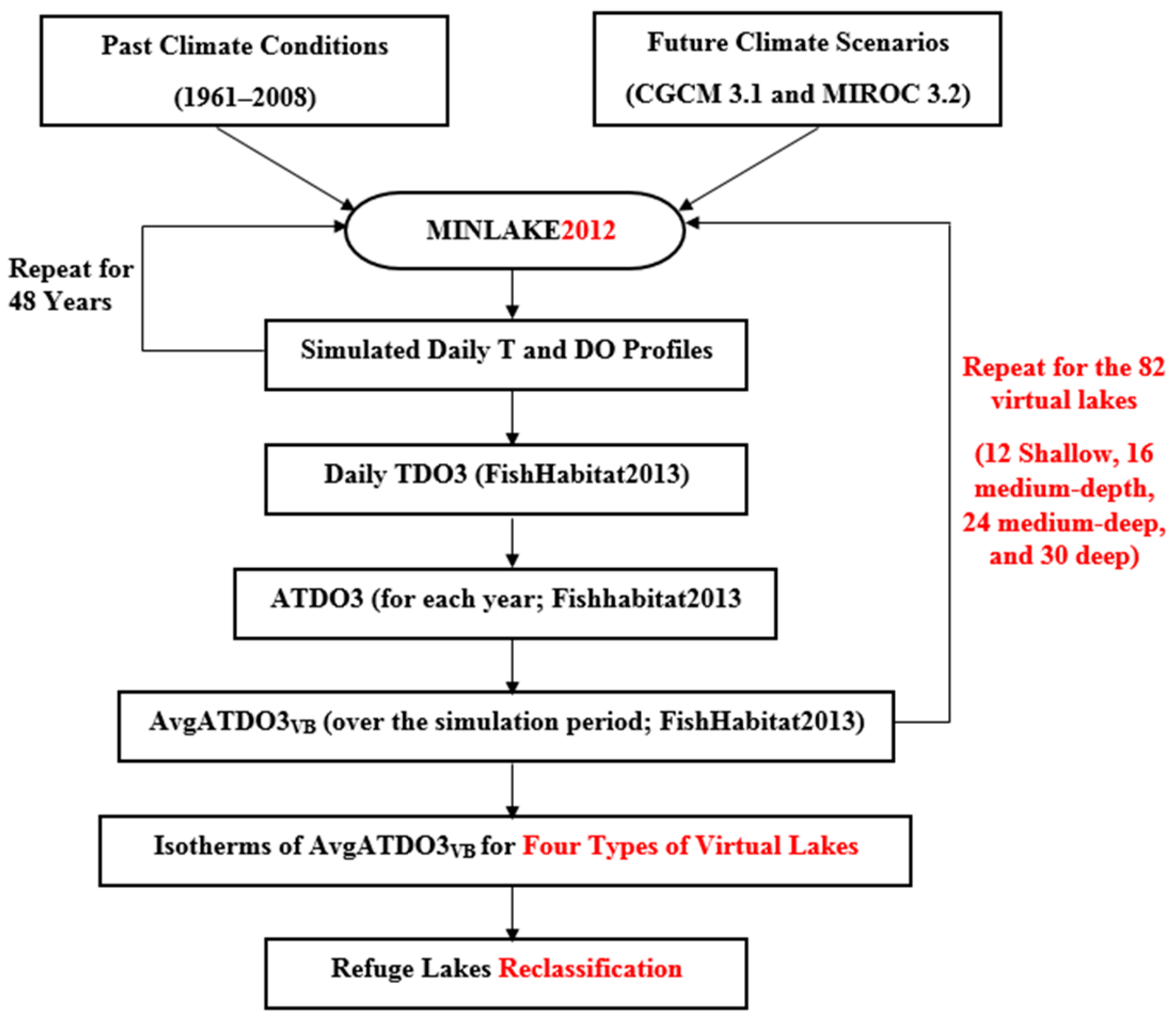
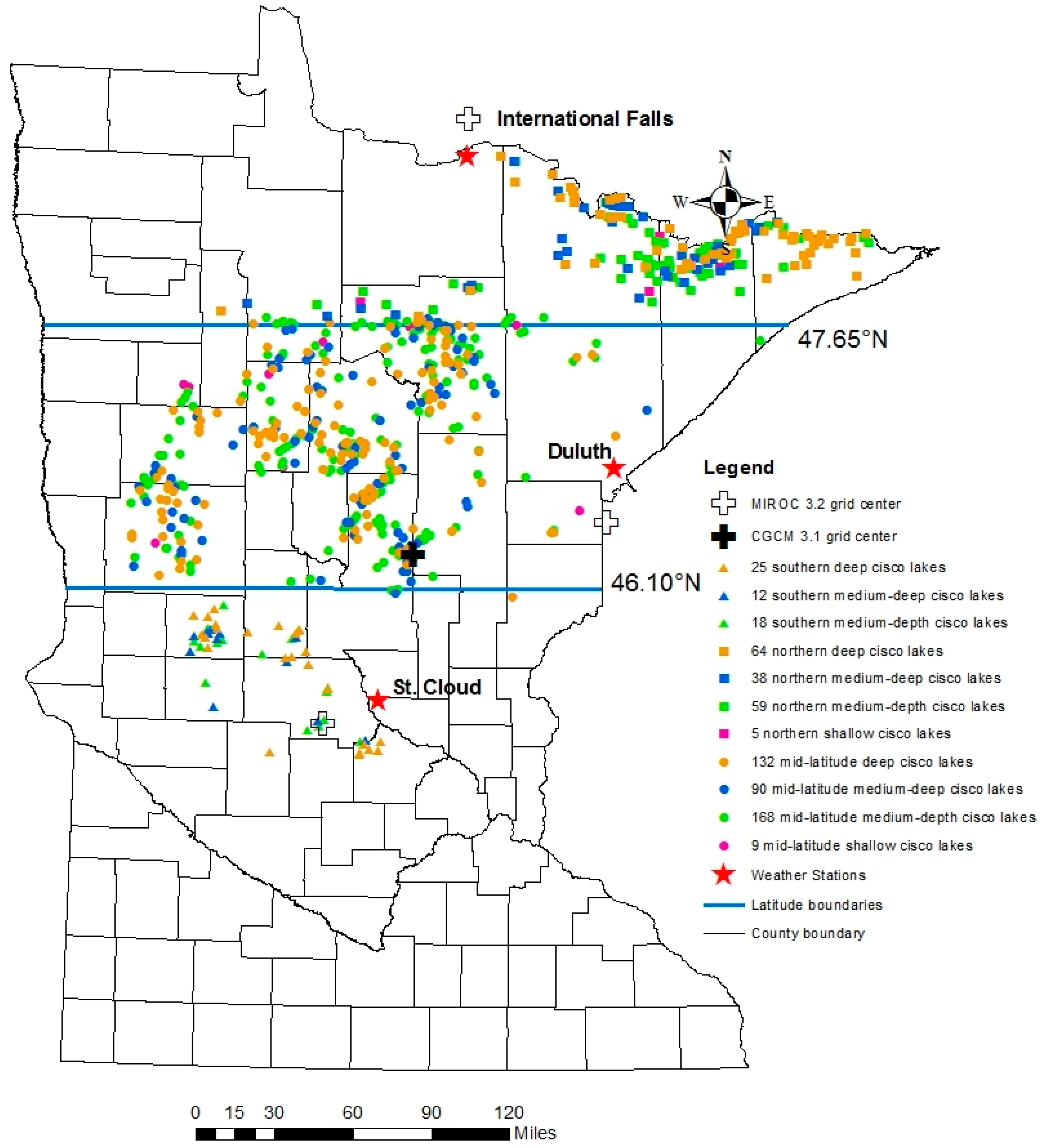
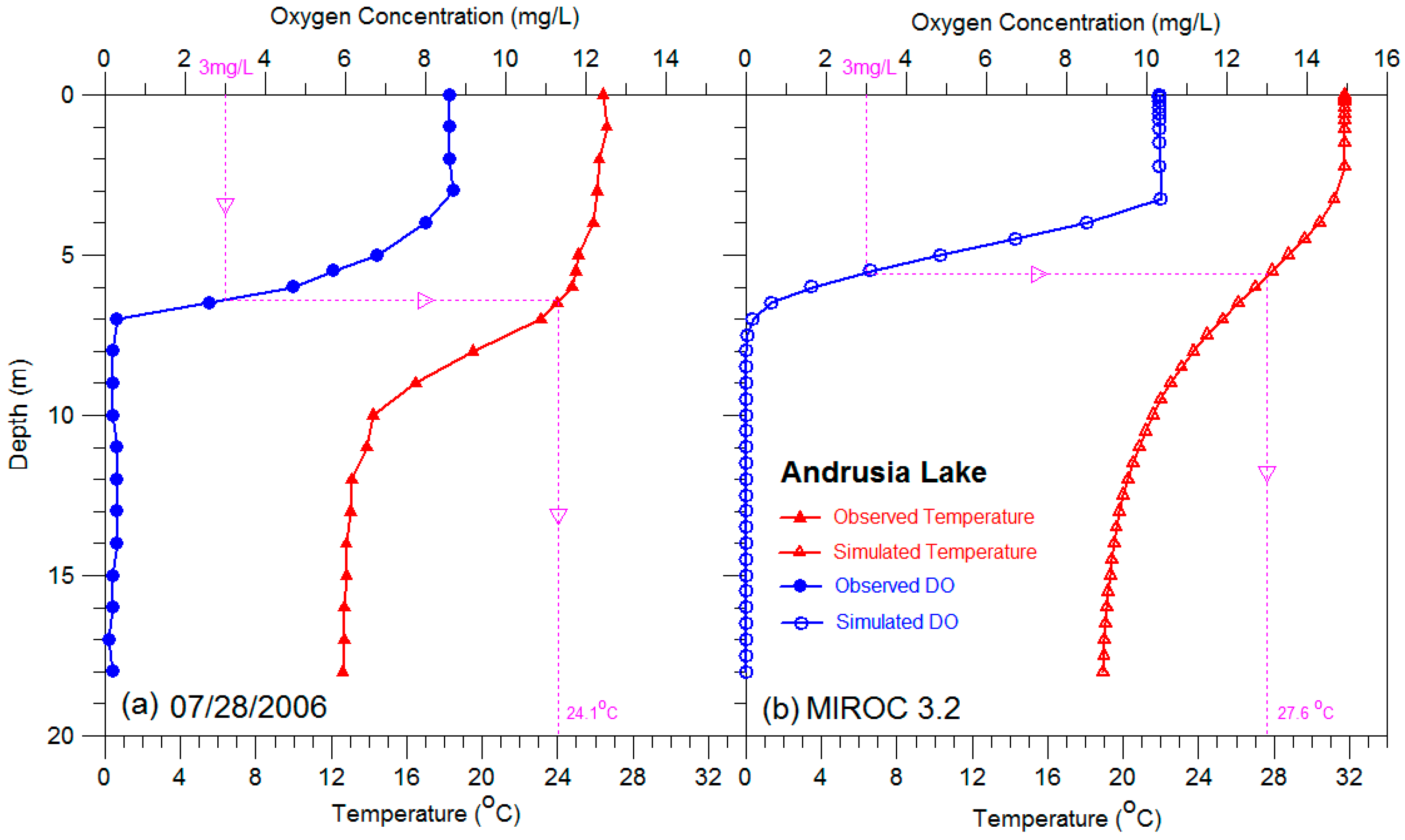
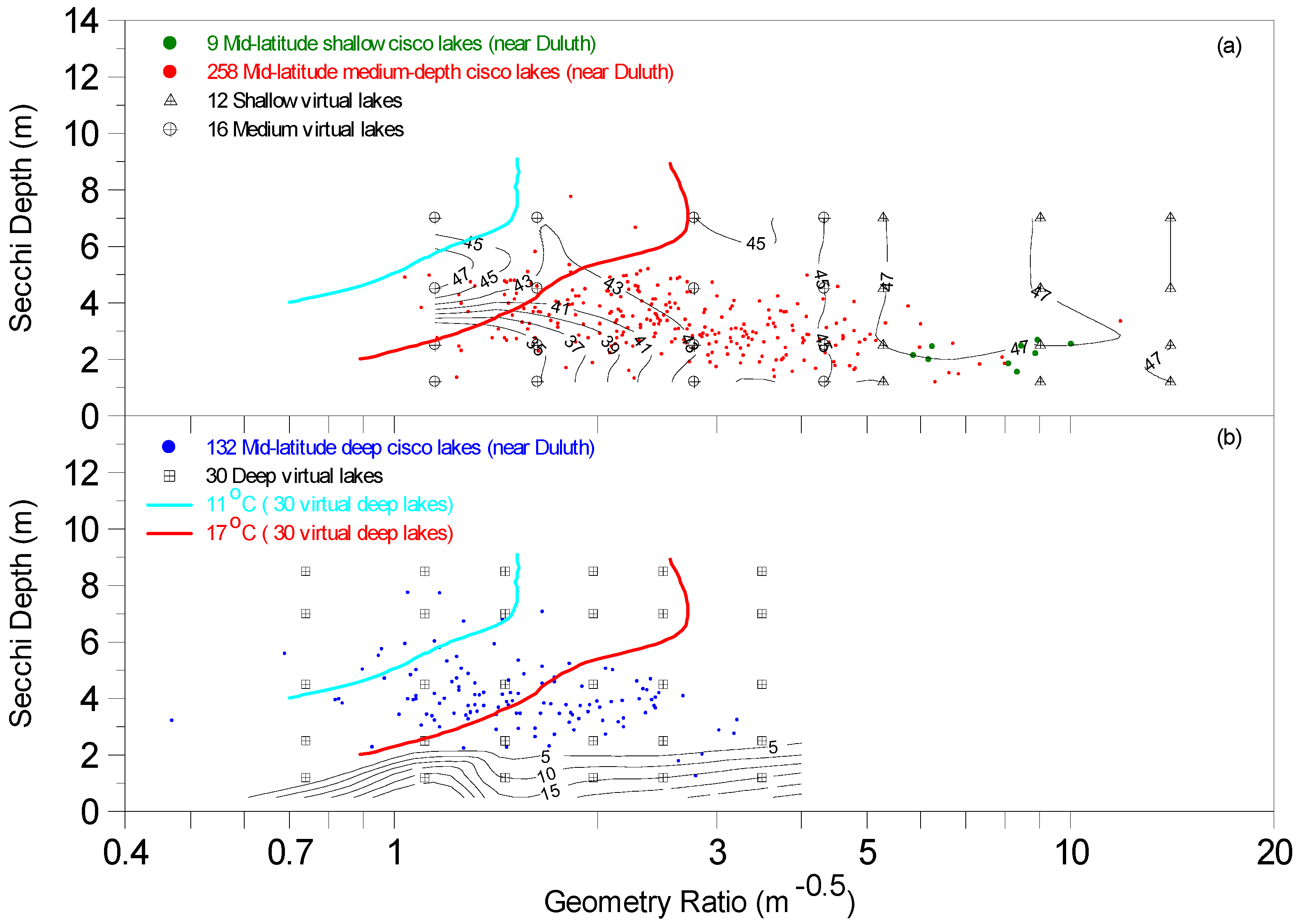
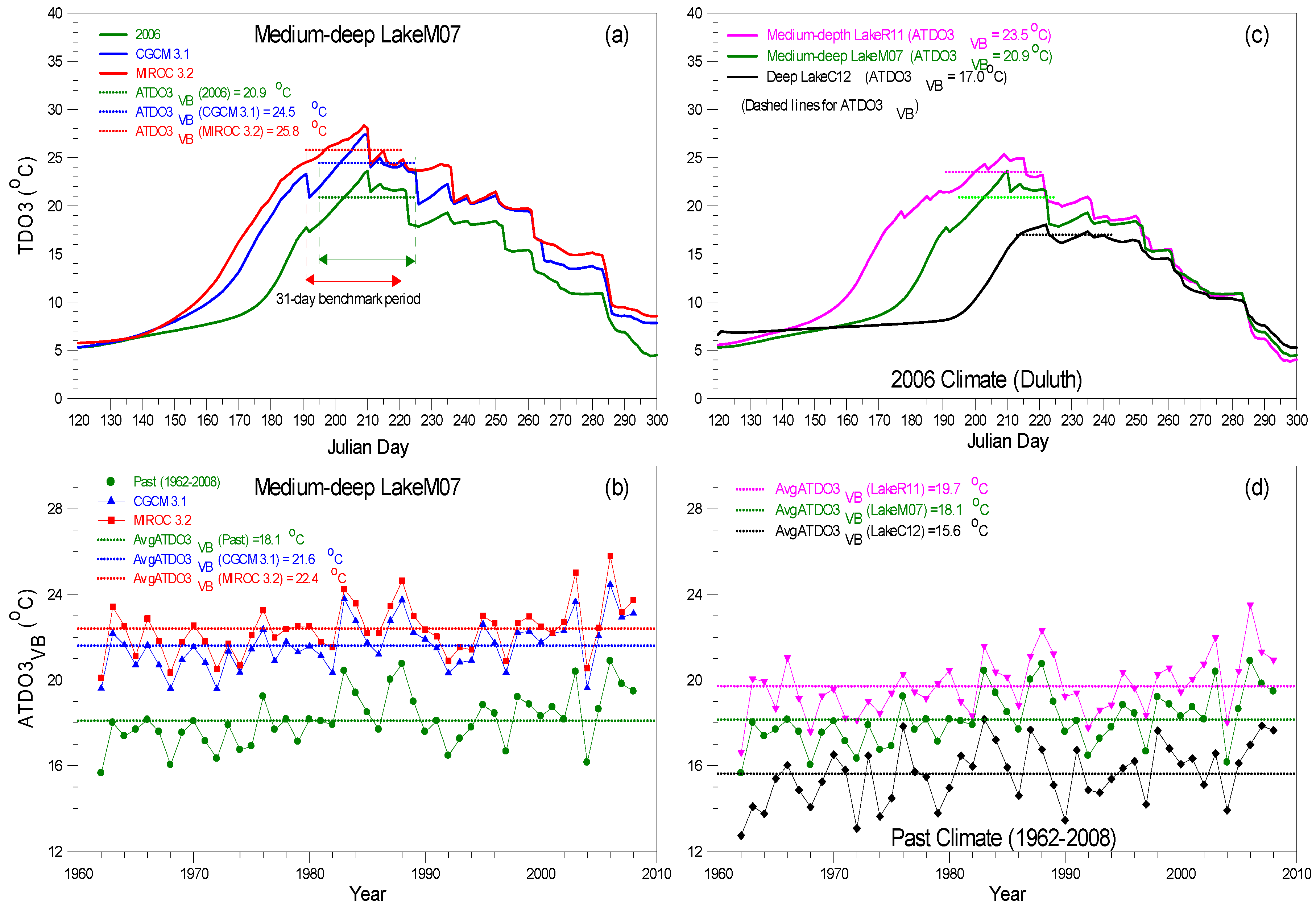
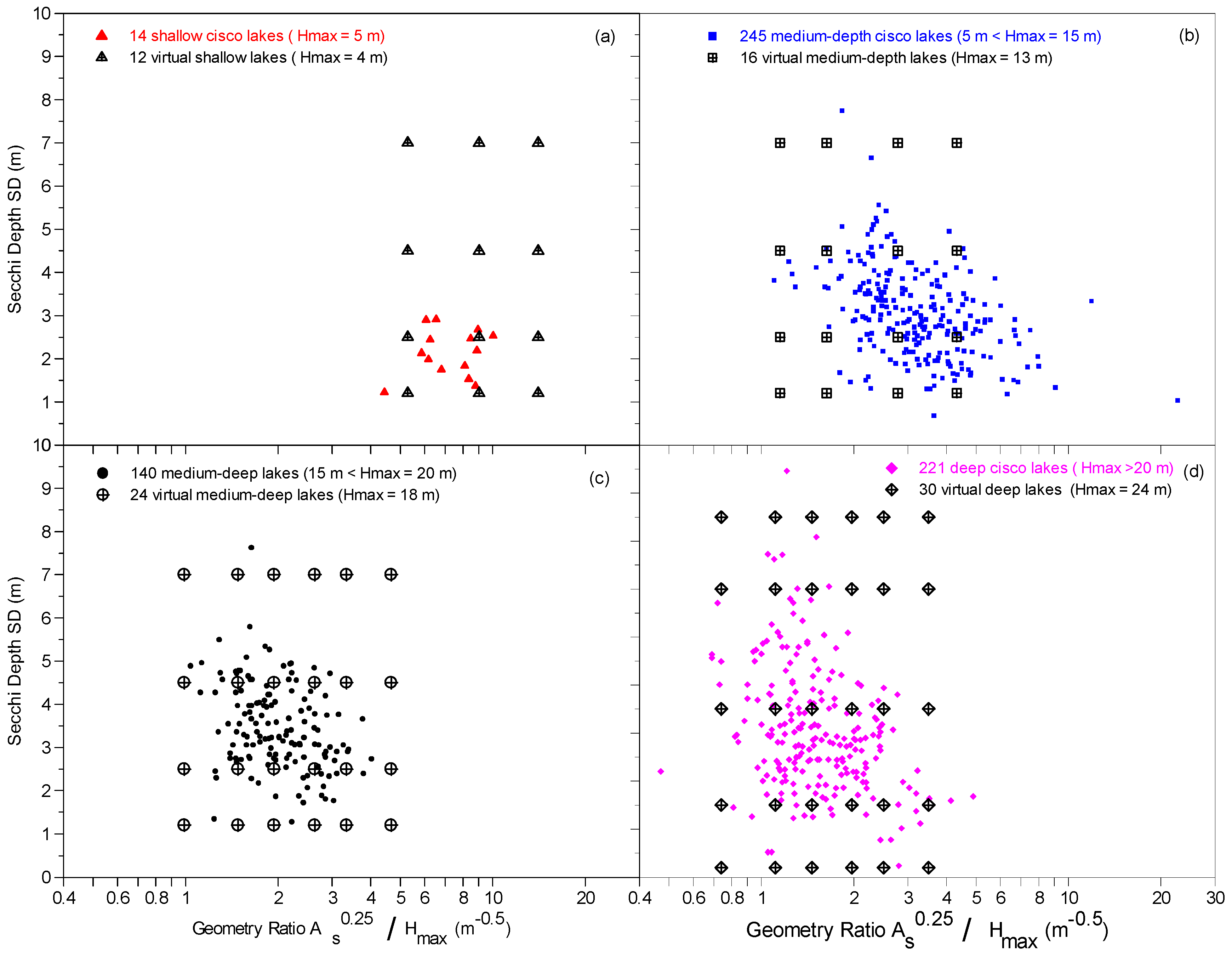
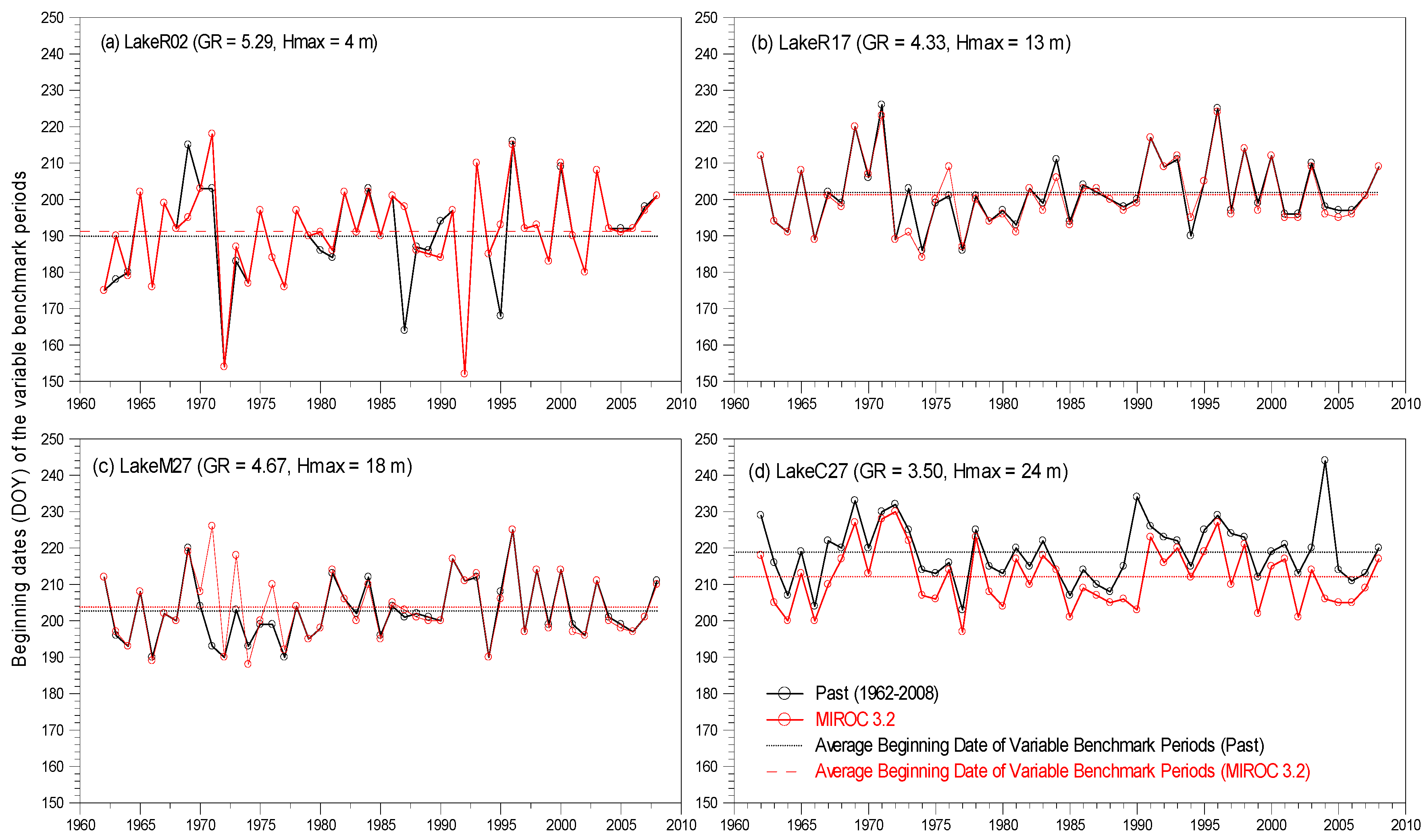
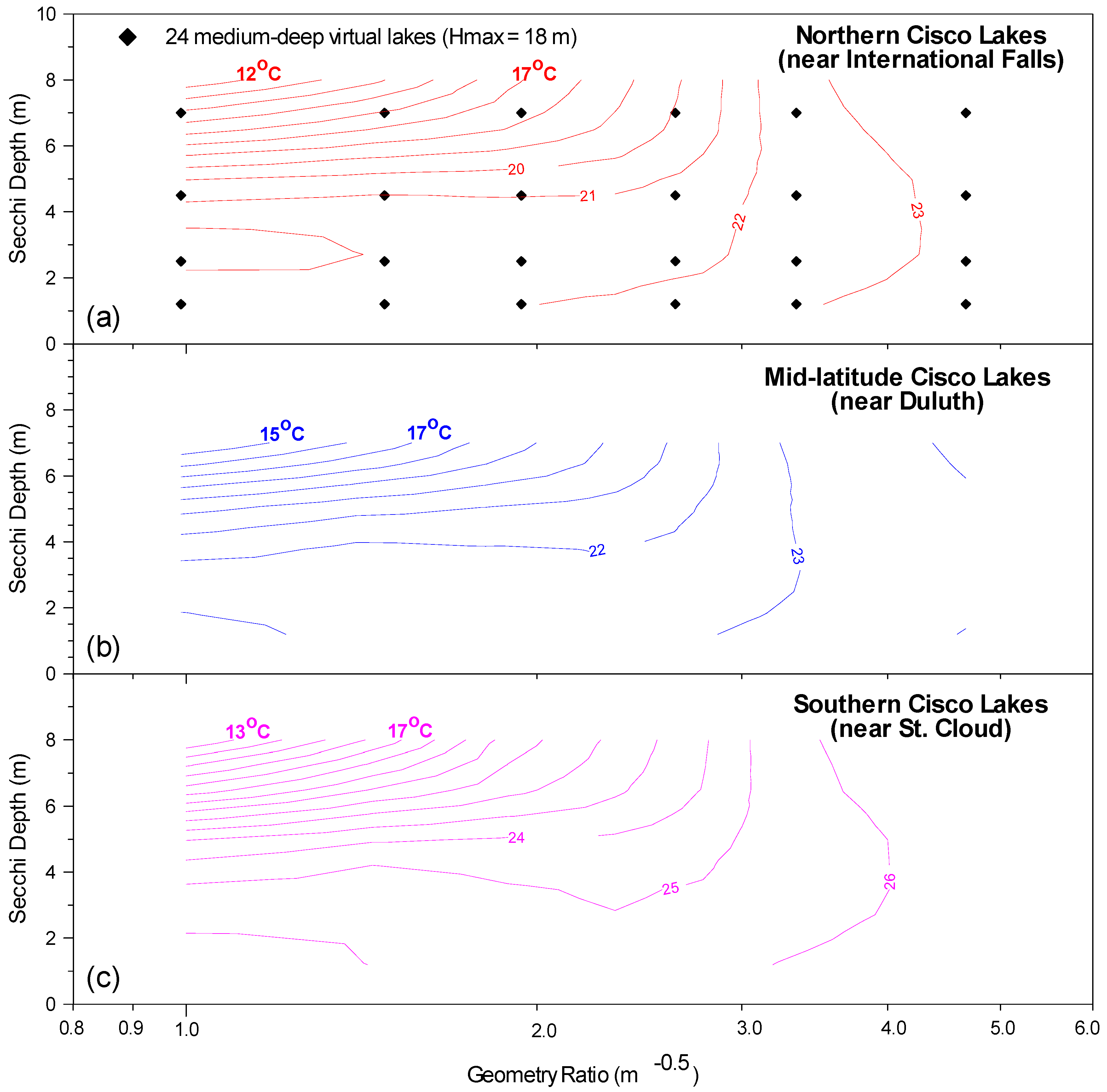
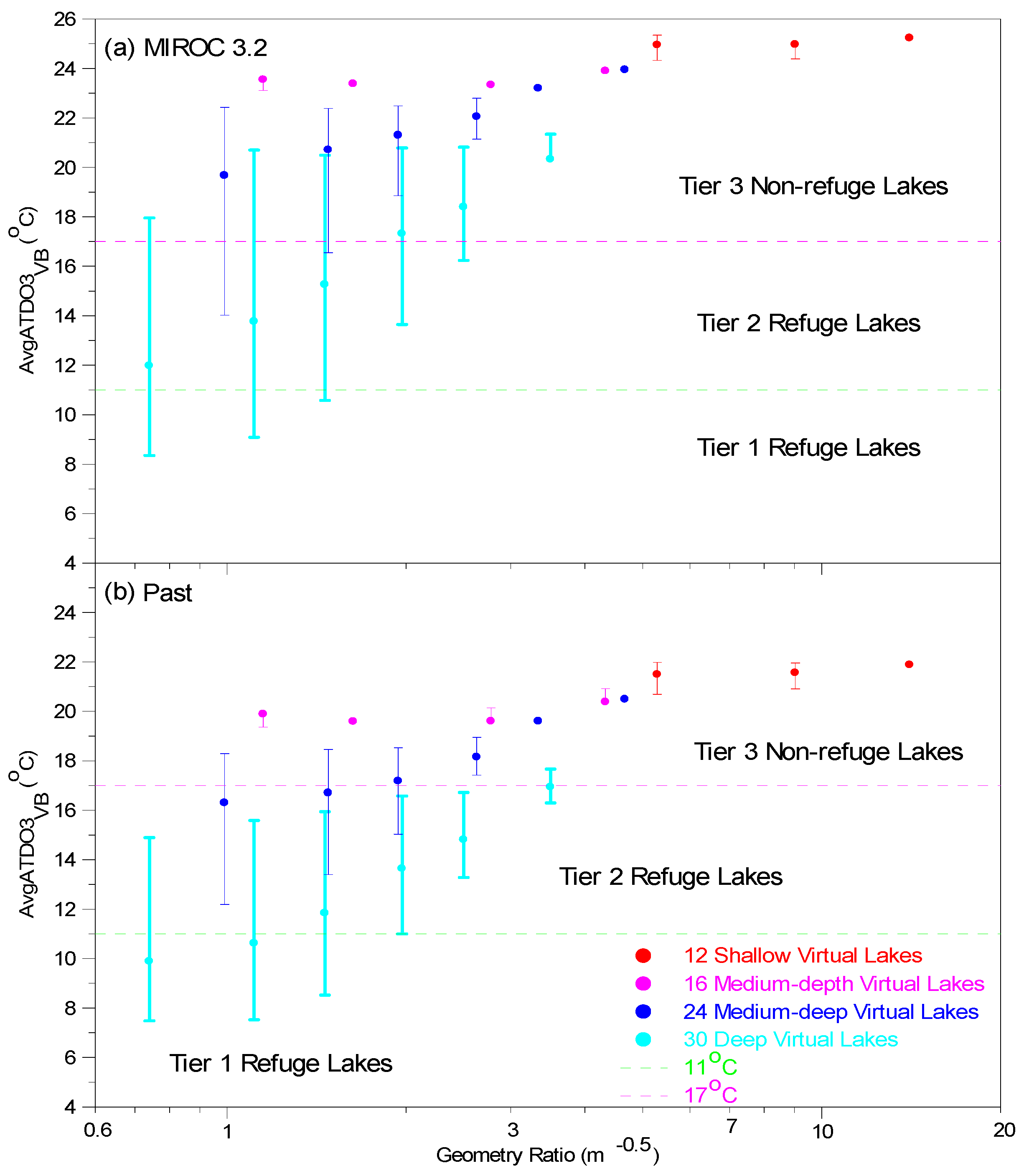
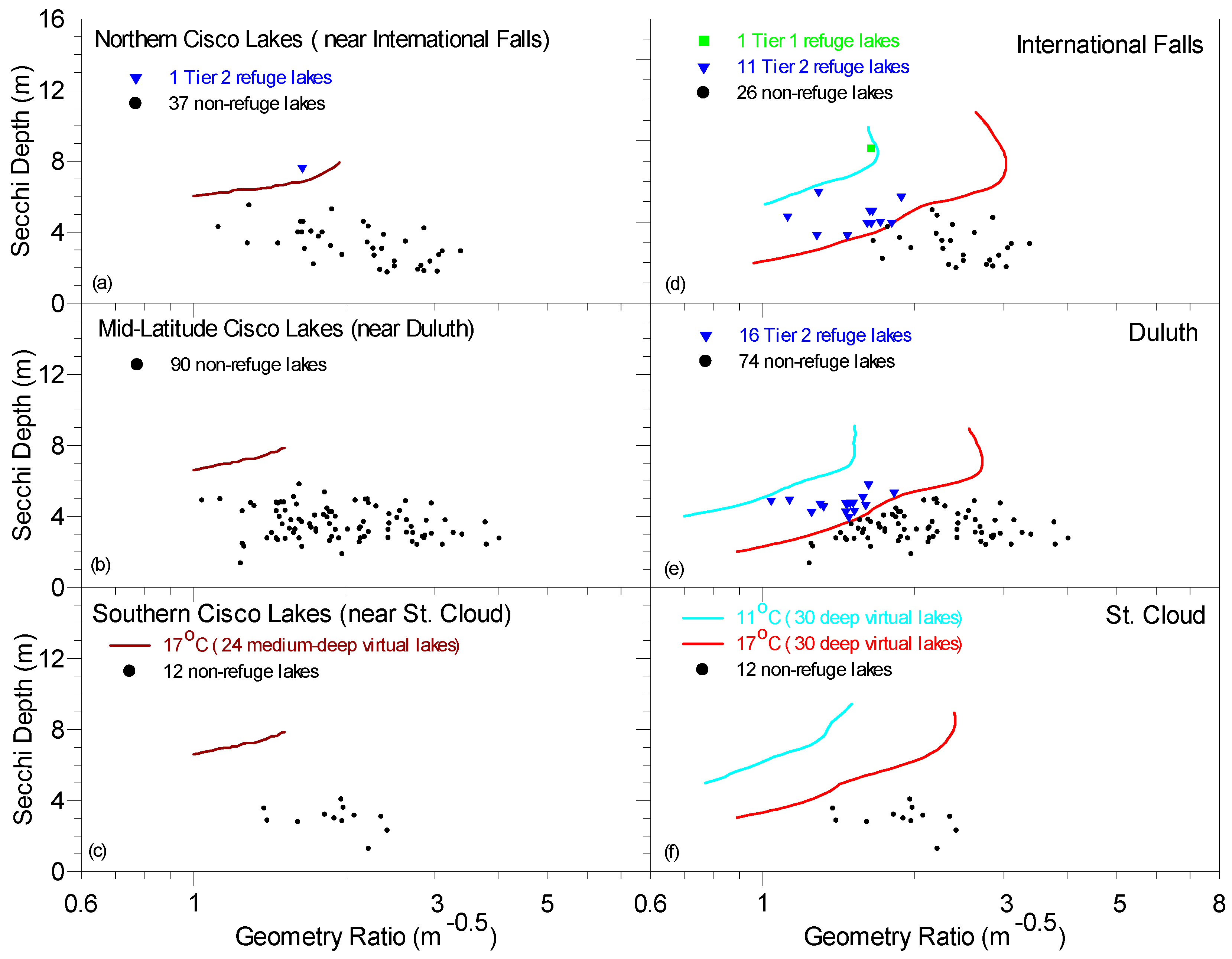
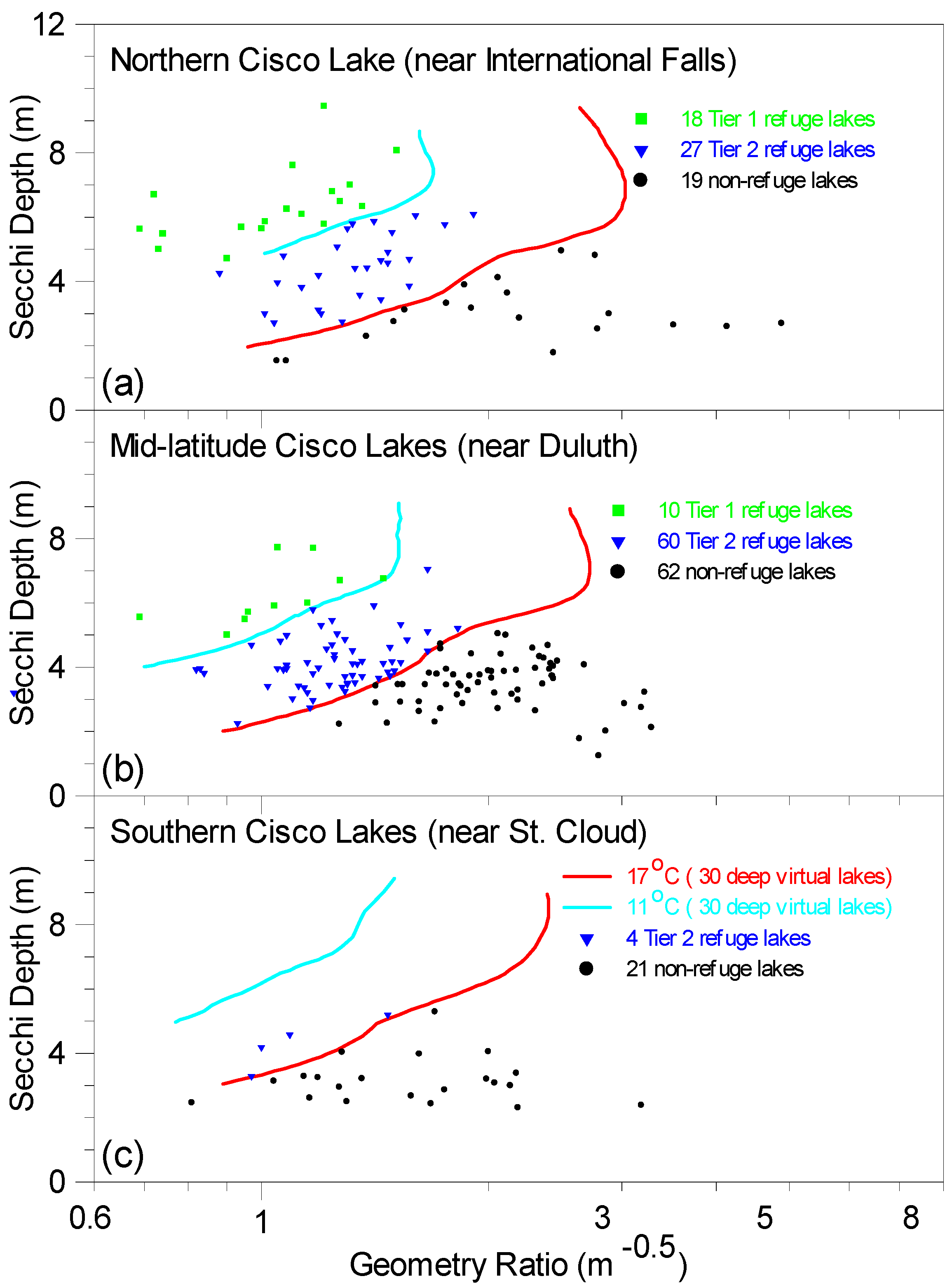
| Abbreviation | Description |
|---|---|
| T | Water temperature (°C) |
| DO | Dissolved oxygen (mg/L) |
| TDO3 | Water temperature where DO equals to 3 mg/L |
| CGCM 3.1 | Coupled General Circulation Model (CGCM) of the earth’s atmosphere and oceans developed by the Canadian Centre for Climate Modeling and Analysis (version 3.1) |
| MIROC 3.2 | The Model for Interdisciplinary Research on Climate (MIROC), a CGCM developed by several Japanese agencies (version 3.2, see the Section 2.1) |
| VB | 31-day variable benchmark period (may vary by lake and by year) when ATDO3 is the highest |
| FB | 31-day fixed bench mark period |
| ATDO3 | Average daily TDO3 over 31-day benchmark period in a simulation year |
| ATDO3FB | Average daily TDO3 over the 31-day fixed benchmark period |
| ATDO3VB | Average daily TDO3 over the 31-day variable benchmark period |
| AvgATDO3 | Multiyear average of ATDO3 over a simulation period |
| AvgATDO3FB | Multiyear average of ATDO3FB over a simulation period (e.g., 1961–2008) |
| AvgATDO3VB | Multiyear average of ATDO3FB over a simulation period |
| AS | Lake surface area (m2 or km2) |
| Hmax | Lake maximum depth (m) |
| GR | Lake geometry ratio = As0.25/Hmax (m−0.5) |
| SD | Lake Secchi depth (m) |
| NSE | Nash–Sutcliff model efficiency |
| RMSE | Root-mean-square errors |
| DOY | Julian day, day of year |
| T1 | Tier 1 refuge lakes (AvgATDO3 < 11 °C) |
| T2 | Tier 2 refuge lakes (11 °C ≤ AvgATDO3 ≤ 17 °C) |
| T3 | Tier 3 non-refuge lakes (AvgATDO3 > 17 °C) |
| Northern cisco lakes | Cisco lakes by latitude near International Falls weather station (Figure 2) |
| Mid-latitude cisco lakes | Cisco lakes by latitude near Duluth weather station (Figure 2) |
| Southern cisco lakes | Cisco lakes by latitude near St. Cloud weather station (Figure 2) |
| Shallow virtual lakes | 12 lakes with maximum depth equal to 4 m [11] |
| Medium-depth virtual lakes | 16 lakes with maximum depth equal to 13 m [11] |
| Medium-deep virtual lakes | 24 lakes with maximum depth equal to 18 m (Table 2) |
| Deep virtual lakes | 30 lakes with maximum depth equal to 24 m [10] |
| 82 virtual lakes | 12 shallow, 16 medium-depth, 24 medium-deep, and 30 deep virtual lakes |
| Surface Area AS (km2) | Secchi Depth SD (m) | Geometry Ratio GR = As0.25/Hmax (m−0.5) | |||
|---|---|---|---|---|---|
| 1.2 1 | 2.5 2 | 4.5 3 | 7.0 3 | ||
| 0.1 | LakeM01 | LakeM02 | LakeM03 | LakeM04 | 0.99 |
| 0.5 | LakeM06 | LakeM07 | LakeM08 | LakeM09 | 1.48 |
| 1.5 | LakeM11 | LakeM12 | LakeM13 | LakeM14 | 1.94 |
| 5.0 | LakeM16 | LakeM17 | LakeM18 | LakeM19 | 2.63 |
| 13.0 | LakeM21 | LakeM22 | LakeM23 | LakeM24 | 3.34 |
| 50.0 | LakeM26 | LakeM27 | LakeM28 | LakeM29 | 4.67 |
| Shallow Cisco Lakes | Medium-Depth Cisco Lakes | Medium-Deep Cisco Lakes | Deep Cisco Lakes | Total Cisco Lakes | |
|---|---|---|---|---|---|
| International Falls | 5 | 59 | 38 | 64 | 166 |
| Duluth | 9 | 168 | 90 | 132 | 399 |
| St. Cloud | 0 | 18 | 12 | 25 | 55 |
| Total | 14 | 245 | 140 | 221 | 620 |
| 12 Shallow Virtual Lakes | International Falls (Northern) | Duluth (Mid-Latitude) | St. Cloud (Southern) | ||||||
|---|---|---|---|---|---|---|---|---|---|
| PAST | CGCM | MIROC | PAST | CGCM | MIROC | PAST | CGCM | MIROC | |
| Maximum | 22.74 | 25.70 | 25.75 | 22.00 | 24.70 | 25.35 | 24.98 | 27.38 | 27.91 |
| Minimum | 21.40 | 24.28 | 24.21 | 20.69 | 23.56 | 24.33 | 23.81 | 26.17 | 26.18 |
| Mean | 22.34 | 25.29 | 25.32 | 21.65 | 24.41 | 25.05 | 24.59 | 27.03 | 27.45 |
| STDEV 1 | 0.48 | 0.49 | 0.54 | 0.44 | 0.37 | 0.36 | 0.41 | 0.43 | 0.65 |
| 16 Medium-Depth Virtual Lakes | |||||||||
| Maximum | 21.41 | 24.36 | 24.49 | 20.92 | 23.66 | 24.27 | 23.65 | 26.17 | 26.71 |
| Minimum | 20.07 | 23.22 | 23.52 | 19.26 | 22.33 | 23.09 | 22.48 | 25.18 | 25.83 |
| Mean | 20.55 | 23.70 | 23.88 | 19.86 | 22.82 | 23.54 | 22.92 | 25.58 | 26.23 |
| STDEV | 0.37 | 0.31 | 0.28 | 0.45 | 0.36 | 0.32 | 0.33 | 0.28 | 0.25 |
| International Falls (Northern) | Duluth (Mid-Latitude) | St. Cloud (Southern) | |||||||
|---|---|---|---|---|---|---|---|---|---|
| PAST | CGCM | MIROC | PAST | CGCM | MIROC | PAST | CGCM | MIROC | |
| Maximum | 21.34 | 24.26 | 24.40 | 20.85 | 23.57 | 24.19 | 23.53 | 26.09 | 26.72 |
| Minimum | 12.75 | 13.98 | 14.44 | 12.19 | 13.07 | 14.03 | 13.92 | 14.52 | 15.64 |
| Mean | 18.56 | 21.53 | 22.01 | 18.07 | 21.12 | 21.81 | 20.96 | 23.79 | 24.48 |
| STDEV | 2.20 | 2.65 | 2.44 | 2.14 | 2.38 | 2.36 | 2.37 | 2.65 | 2.53 |
| (1) | (2) | (3) | (4) | (5) | (6) | (7) |
|---|---|---|---|---|---|---|
| Lake Name (Hmax, GR) 1 | Mortality Date in 2006 | AvgATDO3VB 4 | Range 6 | ATDO3VB (2006) | VB (2006) | Mean TDO3 in 3, 7, 15 Days 7 |
| Cotton (8.5, 6.07) | 205 (24 July) | 22.2 ± 1.3 | 19.4–25.1 | 25.1 | 195–225 | 25.0, 24.9, 24.3 |
| Little Turtle (8.8, 4.21) | 200 (19 July) | 21.8 ± 1.6 | 18.7–25.0 | 25.0 | 192–222 | 24.4, 24.0, 23.2 |
| 8th Crow Wing (9.1, 4.11) | 216 (04 August) | 21.8 ± 1.3 | 19.1–24.6 | 24.6 | 196–226 | 25.8, 25.6, 25.1 |
| Little Pine 2 (11.1, 2.9) | 214 (02 August) | 21.6 ± 1.5 | 19.1–24.6 | 24.6 | 195–225 | 26.2, 26.1, 25.2 |
| Itasca (12.2, 3.32) | 209 (28 July) | 21.3 ± 1.3 | 18.6–24.3 | 24.3 | 195–225 | 24.7, 24.3, 24.0 |
| 7th Crow Wing (12.8, 2.49) | 216 (04 August) | 20.3 ± 1.4 | 18.0–22.5 | 22.5 | 187–217 | 23.7, 23.9, 23.6 |
| Leech (13.0, 10.91) | 211 (30 July) | 21.1 ± 1.4 | 18.2–23.9 | 23.9 | 189–219 | 25.2, 24.6, 24.2 |
| Mille Lacs (13.0, 11.89) | 204 (23 July) | 22.1 ± 1.1 | 19.6–24.2 | 24.2 | 216–246 | 21.9, 21.7, 21.1 |
| Woman (16.5, 4.02) | 210 (29 July) | 21.7 ± 1.5 | 18.5–25.1 | 25.1 | 195–225 | 26.1, 25.6, 24.8 |
| Andrusia (18.3, 2.75) | 202 (21 July) | 21.3 ± 1.3 | 18.9–24.2 | 24.2 | 198–228 | 23.5, 23.1, 22.5 |
| Straight (19.2, 1.94) | 213 (01 August) | 16.2 ± 1.5 | 13.7–21.1 | 21.1 | 198–228 | 19.0, 18.3, 17.1 |
| Little Pine 3 (19.2, 2.77) | 203 (22 July) | 19.8 ± 1.2 5 | 17.1–22.1 | 21.8 | 194–224 | 21.7, 21.3, 20.2 |
| Bemidji (23.2, 3.13) | 208 (27 July) | 19.3 ± 1.0 | 17.8–21.4 | 21.4 | 204–234 | 21.3, 21.0, 20.3 |
| Gull (24.4, 3.26) | 210 (29 July) | 19.9 ± 1.2 | 18.0–22.5 | 22.5 | 205–235 | 22.5, 22.2, 21.5 |
| Pine Mountain (24.4, 2.11) | 207 (26 July) | 21.8 ± 1.3 | 19.6–24.3 | 24.2 | 195–225 | 24.5, 23.9, 23.3 |
| Star (28.7, 2.26) | 200 (19 July) | 20.0 ± 1.1 5 | 17.6–22.4 | 22.4 | 197–227 | 21.6, 21.0, 20.4 |
| Long (39, 1.22) | 218 (06 August) | 18.8 ± 1.3 5 | 16.6–21.7 | 21.1 | 203–233 | 21.9, 21.9, 21.5 |
| Carlos (49.7, 1.15) | 239 (27 August) | 13.4 ± 1.1 5 | 11.2–15.7 | 15.4 | 240–270 | 13.8, 13.4, 12.5 |
| Region (Weather Station) | Lake Categories | Past | MIROC 3.2 | CGCM 3.1 | ||||||
|---|---|---|---|---|---|---|---|---|---|---|
| T1 | T2 | T3 | T1 | T2 | T3 | T1 | T2 | T3 | ||
| Northern Cisco Lakes (near International Falls) | Shallow | 0 | 0 | 5 | 0 | 0 | 5 | 0 | 0 | 5 |
| Medium-depth | 0 | 0 | 59 | 0 | 0 | 59 | 0 | 0 | 59 | |
| Medium-deep | 0 | 5 | 33 | 0 | 1 | 37 | 0 | 1 | 37 | |
| Deep | 37 | 25 | 2 | 18 | 27 | 19 | 23 | 23 | 18 | |
| Total | 37 | 30 | 99 | 18 | 28 | 120 | 23 | 24 | 119 | |
| Mid-latitude Cisco Lakes (near Duluth) | Shallow | 0 | 0 | 9 | 0 | 0 | 9 | 0 | 0 | 9 |
| Medium-depth | 0 | 0 | 168 | 0 | 0 | 168 | 0 | 0 | 168 | |
| Medium-deep | 0 | 25 | 65 | 0 | 0 | 90 | 0 | 3 | 87 | |
| Deep | 41 | 91 | 0 | 10 | 60 | 62 | 10 | 59 | 63 | |
| Total | 41 | 116 | 242 | 10 | 60 | 329 | 10 | 62 | 327 | |
| Southern Cisco Lakes (near St. Cloud) | Shallow | 0 | 0 | 0 | 0 | 0 | 0 | 0 | 0 | 0 |
| Medium-depth | 0 | 0 | 18 | 0 | 0 | 18 | 0 | 0 | 18 | |
| Medium-deep | 0 | 0 | 12 | 0 | 0 | 12 | 0 | 0 | 12 | |
| Deep | 1 | 20 | 4 | 0 | 4 | 21 | 0 | 4 | 21 | |
| Total | 1 | 20 | 34 | 0 | 4 | 51 | 0 | 4 | 51 | |
| All Three Regions | Total | 79 | 166 | 375 | 28 | 92 | 500 | 33 | 90 | 497 |
| Region (Weather Station) | Lake Categories | Past | MIROC 3.2 | CGCM 3.1 | ||||||
|---|---|---|---|---|---|---|---|---|---|---|
| T1 | T2 | T3 | T1 | T2 | T3 | T1 | T2 | T3 | ||
| Northern Cisco Lakes (near International Falls) | Shallow | 0 | 0 | 5 | 0 | 0 | 5 | 0 | 0 | 5 |
| Medium-depth | 1 | 36 | 22 | 0 | 5 | 54 | 0 | 8 | 51 | |
| Medium-deep | 3 | 35 | 0 | 1 | 11 | 26 | 1 | 12 | 25 | |
| Deep | 37 | 25 | 2 | 18 | 27 | 19 | 23 | 23 | 18 | |
| Total | 41 | 96 | 29 | 19 | 43 | 104 | 24 | 43 | 99 | |
| Mid-latitude Cisco Lakes (near Duluth) | Shallow | 0 | 0 | 9 | 0 | 0 | 9 | 0 | 0 | 9 |
| Medium-depth | 3 | 113 | 52 | 0 | 8 | 160 | 0 | 8 | 160 | |
| Medium-deep | 8 | 81 | 1 | 0 | 16 | 74 | 0 | 16 | 74 | |
| Deep | 41 | 91 | 0 | 10 | 60 | 62 | 10 | 59 | 63 | |
| Total | 52 | 285 | 62 | 10 | 84 | 305 | 10 | 83 | 306 | |
| Southern Cisco Lakes (near St. Cloud) | Shallow | 0 | 0 | 0 | 0 | 0 | 0 | 0 | 0 | 0 |
| Medium-depth | 0 | 3 | 15 | 0 | 0 | 18 | 0 | 0 | 18 | |
| Medium-deep | 0 | 8 | 4 | 0 | 0 | 12 | 0 | 0 | 12 | |
| Deep | 1 | 20 | 4 | 0 | 4 | 21 | 0 | 4 | 21 | |
| Total | 1 | 31 | 23 | 0 | 4 | 51 | 0 | 4 | 51 | |
| All Three Regions | Total | 94 | 412 | 114 | 29 | 131 | 460 | 34 | 130 | 456 |
| Climate Scenarios | Method | Tier 1 Refuge Lakes | Tier 2 Refuge Lakes | Total Refuge Lakes | Tier 3 Non-Refuge Lakes |
|---|---|---|---|---|---|
| Past | previous 1 | 94 (15.2%) | 412 (66.5%) | 506 (81.6%) | 114 (18.4%) |
| current | 79 (12.7%) | 166 (26.8%) | 245 (39.5%) | 375 (60.5%) | |
| CGCM 3.1 | previous | 34 (5.5%) | 130 (21.0%) | 164 (26.5%) | 456 (73.6%) |
| current | 33 (5.3%) | 90 (14.5%) | 123 (19.8%) | 497 (80.2%) | |
| MIROC 3.2 | previous | 29 (4.7%) | 131 (21.1%) | 160 (25.8%) | 460 (74.2%) |
| current | 28 (4.5%) | 92 (14.8%) | 120 (19.4%) | 500 (80.7%) |
© 2017 by the authors. Licensee MDPI, Basel, Switzerland. This article is an open access article distributed under the terms and conditions of the Creative Commons Attribution (CC BY) license (http://creativecommons.org/licenses/by/4.0/).
Share and Cite
Jiang, L.; Fang, X.; Chen, G. Refuge Lake Reclassification in 620 Minnesota Cisco Lakes under Future Climate Scenarios. Water 2017, 9, 675. https://doi.org/10.3390/w9090675
Jiang L, Fang X, Chen G. Refuge Lake Reclassification in 620 Minnesota Cisco Lakes under Future Climate Scenarios. Water. 2017; 9(9):675. https://doi.org/10.3390/w9090675
Chicago/Turabian StyleJiang, Liping, Xing Fang, and Gang Chen. 2017. "Refuge Lake Reclassification in 620 Minnesota Cisco Lakes under Future Climate Scenarios" Water 9, no. 9: 675. https://doi.org/10.3390/w9090675






